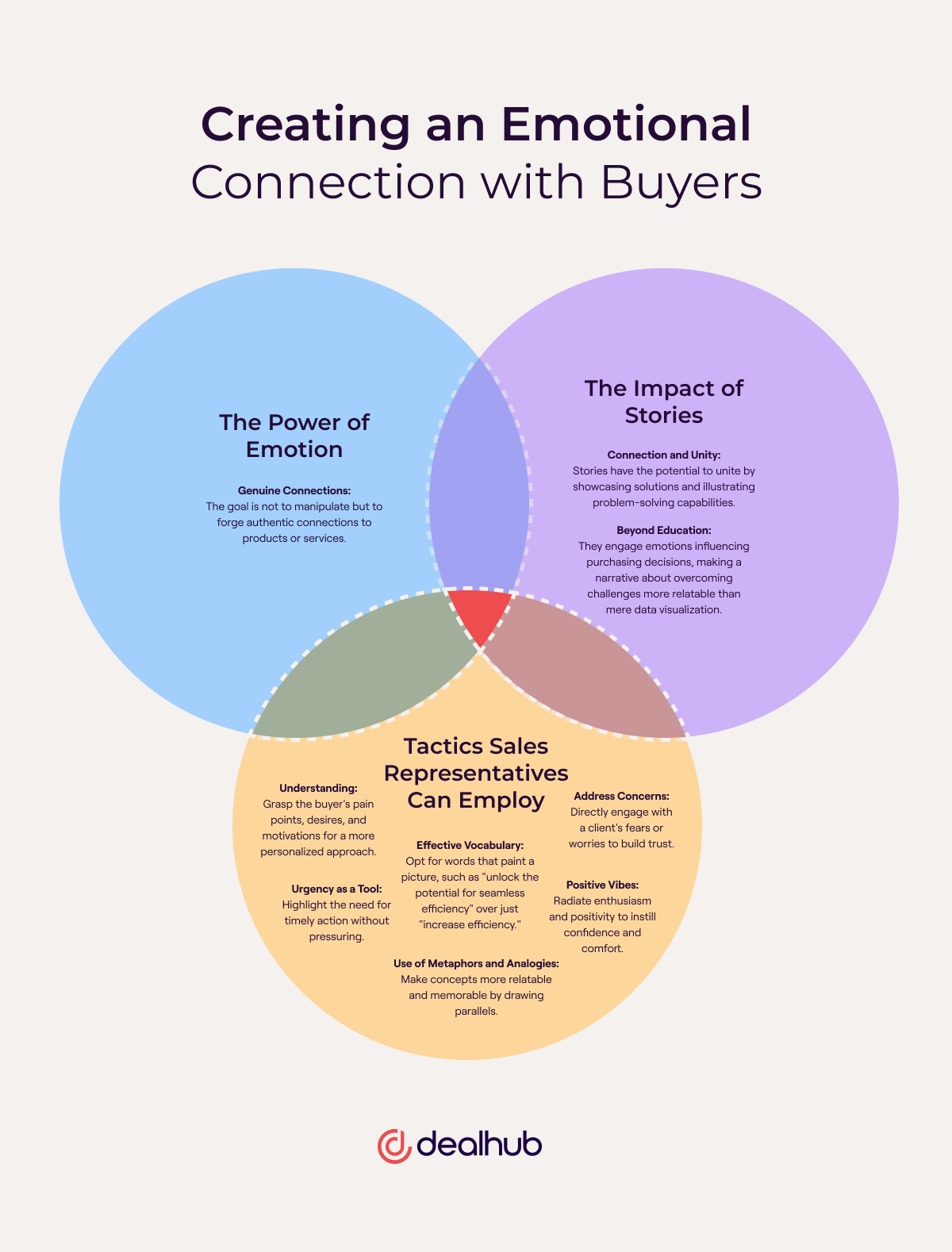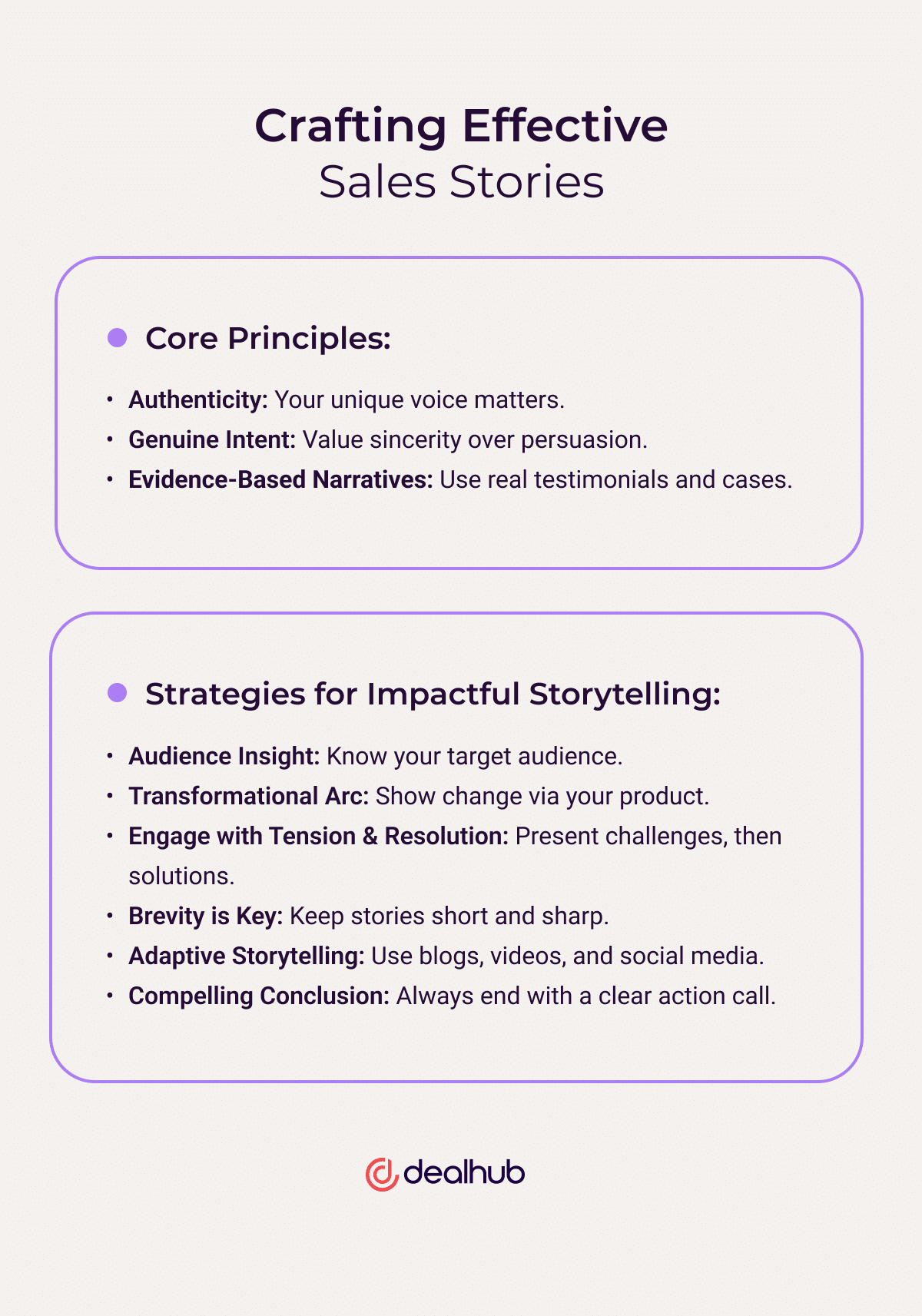If you’re tired of the same old pitch-and-present routine, buckle up! We’re about to explore how storytelling transforms sales by leveraging emotion to bring products to life and foster connections that make a difference.
The role of storytelling in sales
Sure, you could rattle off features and benefits all day long, but KPIs (even great ones!) aren’t likely to make an emotional connection with your audience. Enter storytelling in sales presentations: the bridge between data and emotions.
Humans are naturally drawn to stories; integrating them into your sales process is an opportunity to humanize and connect with your audience. Therefore, instead of presenting a list of facts, consider captivating your clients with tales of real-world challenges, triumphs, and transformations. It’s a shift from the monotony of traditional sales pitches to an engaging narrative that leaves a lasting impression.
Creating an emotional connection with buyers
Injecting emotion is the secret to effective sales. We’re not talking about manipulating feelings; we’re talking about forging authentic connections to a product or service.

Stories have the power to connect and unite us. They showcase a solution in action and illustrate its problem-solving capabilities. Stories do more than educate – they tap into emotions that influence purchasing decisions. After all, a heartwarming story about a small business overcoming adversity is much more relatable than a pie chart. Therefore, placing an emotional story at the center of a business decision helps put success into perspective – on a human scale.
Sales representatives can evoke emotions by:
- Understanding the buyer’s pain points, desires, and motivations
- Using words the right words (say “unlock the potential for seamless efficiency that your team has been longing for” instead of “increase efficiency”)
- Addressing a client’s fears or concerns
- Peppering in metaphors and analogies
- Leveraging urgency
- Expressing enthusiasm and positivity
Illuminating value through stories
Numbers may impress analytical thinkers but they won’t trigger an emotional response. Balancing stats with stories brings value to life, adding color to what could be a dull canvas of business metrics. Remember, your product isn’t just a solution – it’s the hero in the buyer’s journey. Sharing stories of how your offering transforms others’ lives makes it easier for prospects to see the real-world impact of investing in your solution.
Painting pictures of success and transformation
People love a good underdog story. Stories of success and transformation create a vision that prospects can’t help but get excited about. These anecdotes aren’t just inspiring; they’re your secret weapon against objections and skepticism. When doubt creeps in, a good underdog story can be the reassuring hand on your prospect’s shoulder.
You can showcase how your product can lead to success and transformation by:
- Setting the scene. Start by introducing the protagonist – a customer, a business, or even your brand. Describe the initial challenges, obstacles, and the uphill battle they faced. Make it clear that they were the underdog in the situation.
- Introducing your solution. Position your offering as the tool that could level the playing field.
- Highlighting progress. Describe how the protagonist began to progress with your solution’s help.
- Showing Tangible Results. Incorporate specific data, metrics, or outcomes that illustrate the impact of your solution.
- Evoking triumph. As the story progresses, narrate the moments where the underdog starts to outshine expectations and defy the odds.
Enhancing empathy and connection through shared experiences
By sharing relatable experiences with a client, you’re not just selling – you’re building rapport. The act of relating also helps clients empathize.
Build empathy through storytelling by highlighting:
- Shared struggles. Stories about other customers’ challenges will resonate with prospects who have encountered similar hurdles.
- Aspirations and dreams. Share stories of customers who achieved their goals with your solution and paint a picture of success using your product. This creates an emotional connection rooted in shared aspirations.
- Unexpected acts of kindness. Share stories where your company went above and beyond to delight customers. These tales of exceptional service evoke feelings of warmth and trust, leading prospects to imagine how well you’ll treat them.
- Community and belonging. Showcase stories of customers who found a community within your brand. When prospects see others like them forming connections, they feel a sense of belonging and are more likely to join the fold.
Exploring memorability and brand recall
The psychological impact of storytelling ensures that your brand is etched in your prospect’s mind, ready to be recalled when the time is right.
Stories have a remarkable ability to enhance memorability and brand recall. Here’s how:
- Engagement through emotion. When people feel something while reading or hearing a story, the brain creates stronger connections to the information. These emotional triggers provide a framework for memory retention.
- Visualization. Stories encourage people to create mental images while absorbing the content. These visual representations of the story elements act as mental cues that enhance memory recall.
- Surprise and novelty. A well-crafted story might include unexpected twists or unique perspectives. These surprising elements make the story stand out and stick in the memory.
- Repetition and reinforcement. Storytelling allows you to repeat key messages in a narrative context. Repetition is a proven technique for memory retention.
Standing out in a crowded market
Storytelling has been used effectively by various internationally-recognized brands. By studying how some of the biggest names in the world incorporate stories into sales, you might gain some insights into how to organically incorporate storytelling into your sales strategy.
Here are a few of our favorite examples of using storytelling in sales:
Dove
Dove’s “Real Beauty” campaign is a prime example of storytelling that helped differentiate the brand. Instead of focusing solely on product features, Dove told stories celebrating diverse body types and challenging conventional beauty standards. The campaign’s emotional and empowering stories resonated with consumers, making Dove a leader in the beauty industry.
Apple
Apple weaves storytelling into every aspect of its product. For example, Apple commercials often focus on telling emotional stories, such as families using FaceTime, friends sharing music through AirPods, or artists creating with the iPad Pro. Its retail stores are also designed to tell a story. The layout, minimalistic design, and product placement all contribute to a narrative of simplicity, elegance, and innovation. This simplicity-meet-innovation storyline is echoed in Apple’s design and packaging which continue to convey a cohesive sense of elegance and ease.
Nike
Nike’s “Just Do It” campaign is legendary for its storytelling prowess. The campaign focuses on athletes sharing stories of overcoming obstacles, pushing limits, and achieving greatness. These narratives align with Nike’s values of empowerment, determination, and athleticism, setting the brand apart in the competitive sportswear market.
Warby Parker
Warby Parker disrupted the eyewear industry by telling how it was founded to provide affordable and stylish eyewear, challenging the traditional high-priced options. The brand’s commitment to social responsibility and affordable eyewear resonated with consumers, setting it apart from other eyewear retailers.
Crafting effective sales stories

You, too, can craft stories that resonate. While building your story, keep these three components in mind:
- Authenticity. Tell stories your way in your voice.
- Sincerity over persuasion. Once customers feel like they are being “sold to,” their rational mind takes over, and you lose the emotional power of storytelling.
- Proof. Sprinkle in testimonials and use cases. Real stories pack a punch!
To craft impactful stories, remember to:
- Know your audience. Understand your target audience’s needs, pain points, and aspirations. Then, tailor your stories to make them feel like you’re speaking directly to them.
- Highlight transformation. Showcase how your product or service transformed a situation, business, or individual. This gives prospects a vision of the positive change they could experience.
- Build tension and resolution. Stories thrive on tension and resolution. Present a problem or challenge your prospect might relate to, then demonstrate how your solution resolves it.
- Keep it concise. While stories add depth, they shouldn’t drag on. Keep your story brief and to the point. Respect your prospect’s time and focus on the key takeaways.
- Use various formats. Adapt your stories to written content, videos, social media, and other platforms to reach your audience effectively.
- End with a call to action. Conclude your story with a clear call to action. Guide your prospect on the next steps, whether scheduling a demo, requesting more information, or making a purchase.
Storytelling: a must-have sales strategy
So there you have it, a journey through the power of storytelling in sales. The times are changing, and so are consumer preferences. Modern customers are looking for connections rather than pitches. As the digital age evolves, storytelling will become ever more critical to an effective sales strategy. Embrace it, weave it into your personal sales approach, and watch your prospects convert and remain loyal over time.
Remember, it’s not just about selling; it’s about telling a story that sells. So, paint your narrative, make an emotional connection, and let your prospects envision the success they’re destined for. Story by story, connection by connection, you’ll transform how you sell, one captivating tale at a time.





